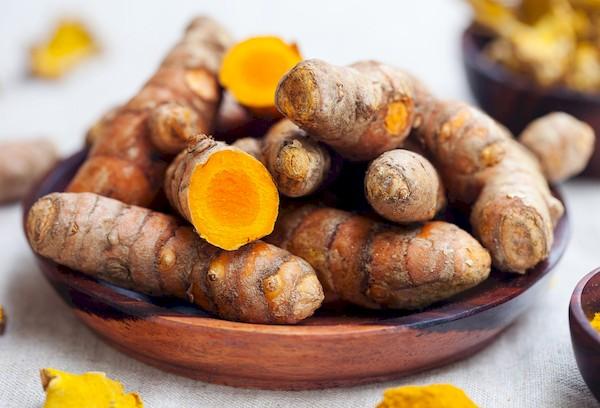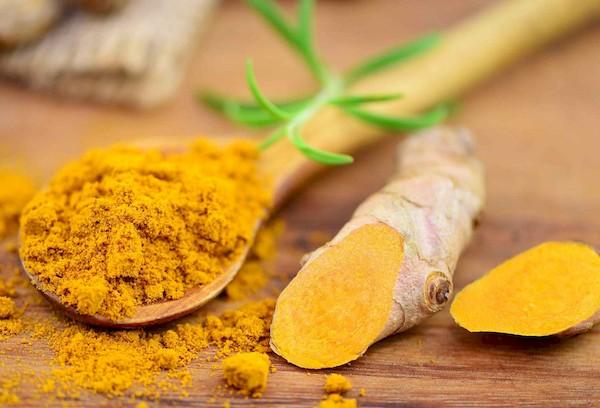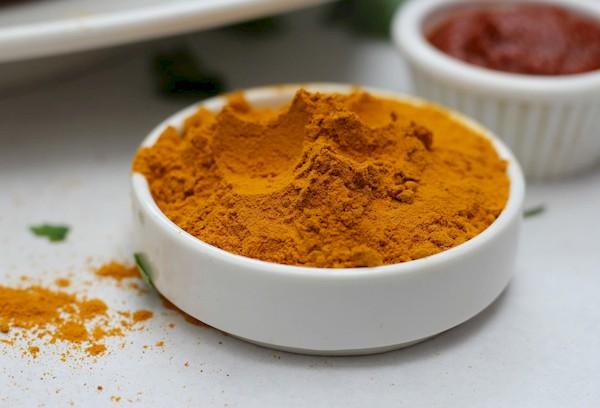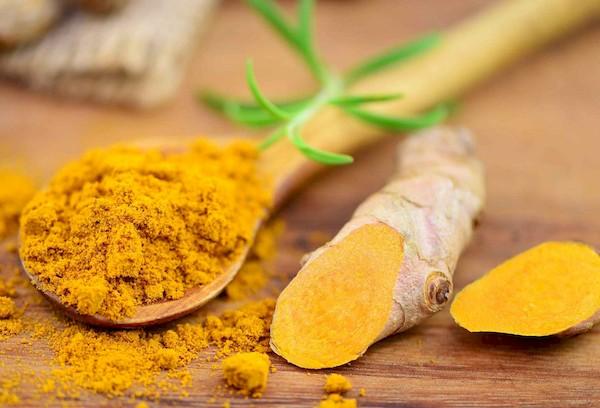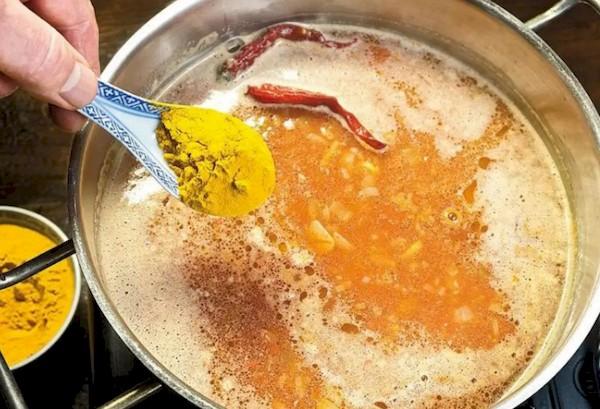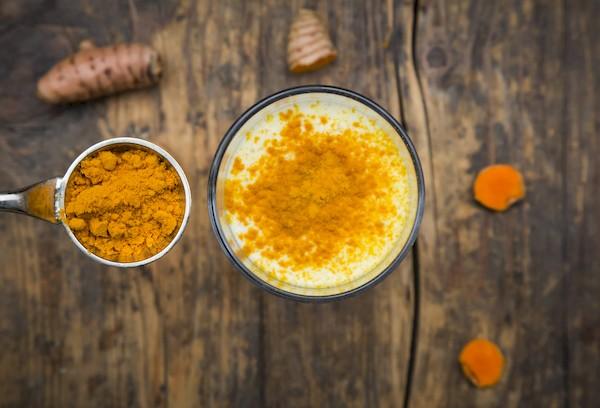What dishes are turmeric added to?
Often many people do not know where to add turmeric and what characteristics the spice has. This seasoning is a key ingredient for preparing oriental dishes and all kinds of drinks. The product is very valuable, because in addition to its taste, it contains a huge amount of substances beneficial to the body.
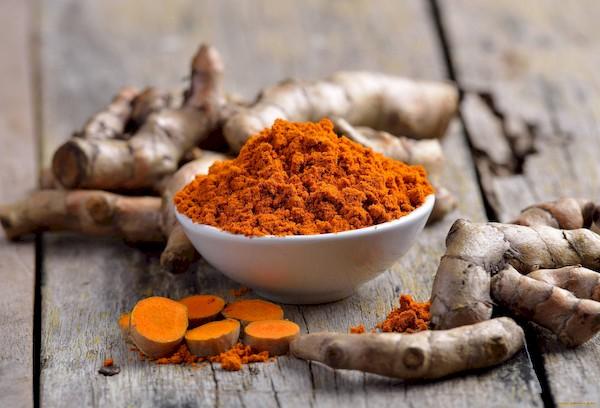
Description of the spice
To produce the spice, as a rule, the rhizomes of one of two types of plants are taken: long turmeric or aromatic turmeric. This Indian spice is most often produced in powder form, but in some cases also as a product crushed into small pieces. The leaves, stems and rhizomes of the plant of the same name contain the pigment curcumin and essential oils. Thanks to them, the seasoning has a bright orange color, which colors the food.
The cedoaria variety is another common option for raw materials for the product, but it is used only for the preparation of alcohol, for example, liqueur.
Cooking is not the only area where the spice is used. Turmeric is also a dye that is popular in India and countries bordering it. The substance is often used in the East in folk medicine.
Composition of turmeric
The chemical composition of the spice is very nutritious. It contains many vitamins, micro- and macroelements, as well as antioxidants. Thus, turmeric contains (% of the daily value of an adult per 100 g of product):
- 990% manganese - it helps in the formation of bone and connective tissue, is the main substance for some enzymes, and is involved in the synthesis of cholesterol;
- 306% iron - is part of a number of proteins, ensures the transport of oxygen in the blood, supports redox processes;
- 130% copper - the component is part of the enzymes necessary for the metabolism of iron, and also stimulates the absorption of proteins and glucose;
- 83% potassium - it plays a key role in maintaining balances in the body, including electrolyte, water and acid; indispensable for conducting nerve impulses and regulating pressure in the body;
- 52% magnesium - the substance plays an important role as an anti-stress factor for humans, regulates processes occurring in the central nervous system; thanks to it, the muscles are able to relax;
- 38% zinc, phosphorus - the first is important for the course of internal processes, is involved in the breakdown of proteins, fats, carbohydrates and nucleic acids, regulates the functions of a number of genes; the second is involved in energy exchange, saturation of bones with minerals, maintaining acid-base balance;
- 30% vitamin E is a powerful antioxidant that is of great importance for the gonads, skin and heart muscles;
- 17% calcium - a substance that, in addition to ensuring bone strength, affects the nervous system and muscle contraction;
- 11% vitamin K (phylloquinone), selenium - the first helps in blood clotting; the second is a strong antioxidant, also involved in the synthesis of thyroid hormones;
- 5-11% of B vitamins, except B12, regulate physiological processes, the production of enzymes, heat, hormones, etc.
Turmeric also contains essential oils.They protect the body from bacteria and infections, eliminate free radicals, and tone. This is because these components contain from 500 to 1000 types of different substances, including terpenoids, hydrocarbon compounds, alcohols and others.
Scientists from all over the world are conducting research on the chemical properties of the spice. Based on them, recommendations for the use of this product are formed: why the seasoning should be added to food and how much turmeric is recommended to be consumed. Thus, American doctor Michael Greger advises everyone to include at least 1/2 teaspoon of this spice in their diet every day. People who often eat dishes with turmeric strengthen their immune system, improve their mood faster and relieve fatigue and tension more easily.
Speaking about the nutritional value of the spice, we can note the following indicators (per 100 g):
- 312 kcal;
- 10 g protein;
- 3 grams of fat;
- 44 grams of carbohydrates, including 22 grams of dietary fiber.
IMPORTANT. Turmeric is contraindicated for people with gallstones, because when it enters the body, it stimulates its contraction and the removal of half of the contents. If there are problems with the functioning of the organ, then the spice can cause severe pain.
Taste characteristics
Although turmeric is a relative of ginger, they have nothing in common in taste or smell. After tasting the spice, you may experience unpleasant sensations and bitterness. And after sniffing, a person will notice a specific and even burning aroma.
In its raw form, this spice does not cause delight. But when it becomes a component of any dish, the picture changes. The smell becomes special, soft, and the taste is not at all pronounced, but complements and reveals the main ingredient of the dish.In addition, the spice turns everything orange, which will definitely surprise guests when served.
How is turmeric used in cooking?
Only two types of plants out of forty existing ones appear in home cooking: long turmeric and aromatic turmeric. They are often added to completely different dishes: from drinks to desserts. Spice powder is often used in the confectionery industry.
In everyday life, curcuma longa is called turmeric. Unlike other types, this variety has a broader purpose. For example, the powder is a key ingredient in curry mixtures and is added when making mustard sauce.
It is often used as a natural dye for:
- hard cheeses;
- yoghurts;
- vegetable and fruit chips;
- cookies and other baked goods;
- salad dressings and sauces in general;
- margarine.
We must not forget that turmeric is an independent spice that can be used in completely different variations.
It is also worth mentioning that Turmeric cedoaria and Turmeric are also used in the food industry, only in the food industry for the production of starch and alcohol.
What dishes are they added to?
In what dishes is it customary to add turmeric? This spice is used to prepare oriental dishes: pilaf, Indian curry, daal, hummus, chicken curry or Thai turmeric rice. This spice can be used in many recipes, giving special flavors to products. What dishes is the spice suitable for?
The seasoning will be useful for cooking:
- broth-based soups and cream soups;
- pastes with various combinations;
- sauces;
- baked vegetables;
- any side dish;
- porridge;
- desserts.
Interestingly, very little seasoning is required to impart a characteristic taste and smell.For example, according to a traditional hummus recipe, you need to add only 1/4 teaspoon of spice, and for a small portion of pilaf - 1/2.
What spices does it go with?
Turmeric goes well with spicy spices with a pronounced taste and smell, complementing them with its properties. So, it often appears in various mixtures. The most famous of them is curry. To prepare it, use turmeric, coriander, ground red hot pepper, cardamom, cumin and basil.
The list of the best seasonings to combine includes barberry and saffron - this combination is always used when preparing pilaf. Turmeric is also ideal to use with cinnamon.
IMPORTANT. When combined with black pepper, turmeric enhances its antioxidant effects 2000 times. You only need a pinch per half teaspoon of orange spice.
Adding Turmeric to Drinks
Turmeric drinks are becoming more common these days. There are huge advantages to this. Firstly, the absorption of useful elements occurs several times faster, because the liquid is digested in much less time. Secondly, this is a great option to diversify your diet and try new combinations.
How to use turmeric in making drinks? The simplest thing is to add to taste in tea or coffee, as well as in smoothies, lemonades or milkshakes.
Recently, another drink has become popular, the key ingredient of which is this spice - turmeric latte.
It can also be prepared at home.
RECIPE. Mix 1/4 tsp in a container. spices turmeric, ginger, cinnamon and a pinch of black pepper with a glass of vegetable milk (250 ml).Add vanilla and cardamom if desired, as well as sweetener - honey or Jerusalem artichoke syrup to taste. Stirring well, heat the mixture over low heat, but do not let it boil. Pour into a cup. A tasty and healthy drink is ready.
There are many options for using turmeric in cooking. You can find a use for the spice to suit every taste and discover new healthy food combinations.
